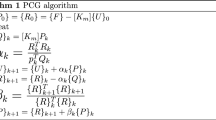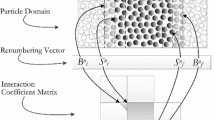Abstract
The finite element analysis of complex structure often requires a refine mesh in some local domain. To reduce the computation time, an explicit asynchronous step parallel computing method is proposed. The domain decomposition with overlapping node method is used to divide the model into different subdomains. The multiple overlapping nodes between different subdomains constitute the coupling region. Each subdomain selects the time step based on the mesh characteristics. The subcycling method is adopted to tackle the matching of asynchronous step boundary. The subdomain model, boundary information and calculation results are stored in parallel files which mean the overall finite element analysis process is implemented in parallel. The validity and efficiency of the proposed method are verified through three simulation cases which conducted on Tianhe 2 multi-core supercomputers. The results of simulation cases show that the proposed method has a higher accuracy than classic subcycling method under the same time step. The total speedup of the algorithm relates to the step ratios between subdomains, the number of subdomain and the load balance. This approach offers an efficient way to solve large-scale and super-scale structural dynamics analysis with local refine mesh.














Similar content being viewed by others
References
Krysl P, Bittnar Z (2001) Parallel explicit finite element solid dynamics with domain decomposition and message passing: dual partitioning scalability. Comput Struct 79(3):345–360
Hughes TJR (2012) The finite element method: linear static and dynamic finite element analysis. Courier Corporation, North Chelmsford
Vanderbauwhede W, Takemi T (2016) An analysis of the feasibility and benefits of GPU/multicore acceleration of the Weather Research and Forecasting model. Concurr Comput Pract Exp 28(7):2052–2072
Zhang J, Sha C, Wu Y et al (2017) The novel implicit LU-SGS parallel iterative method based on the diffusion equation of a nuclear reactor on a GPU cluster. Comput Phys Commun 211:16–22
Porth O, Xia C, Hendrix T et al (2014) MPI-AMRVAC for solar and astrophysics. Astrophys J Suppl Ser 214(1):4
Cheng Z, Shaffer E, Yeh R et al (2017) Efficient parallel optimization of volume meshes on heterogeneous computing systems. Eng Comput 33(4):717–726
Cai Y, Li G, Liu W (2018) Parallelized implementation of an explicit finite element method in many integrated core (MIC) architecture. Adv Eng Softw 116:50–59
Das R (2017) GPUs in subsurface simulation: an investigation. Eng Comput 33(4):919–934
Toselli A, Widlund OB (2005) Domain decomposition methods: algorithms and theory. Springer, Berlin
Ghanem A, Torkhani M, Mahjoubi N, et al (2013) Arlequin framework for multi-model, multi-time scale and heterogeneous time integrators for structural transient dynamics. Comput Methods Appl Mech Eng 254:292–308
Farhat C, Roux FX (1991) A method of finite element tearing and interconnecting and its parallel solution algorithm. Int J Numer Method Eng 32(6):1205–1227
Gosselet P, Rixen D, Roux FX et al (2015) Simultaneous FETI and block FETI: robust domain decomposition with multiple search directions. Int J Numer Method Eng 104(10):905–927
Rheinbach O (2009) Parallel iterative substructuring in structural mechanics. Arch Comput Methods Eng 16(4):425–463
Singh H (2013) Relative study of solvers for finite element analysis. Int J Comput Technol 4(2):363–370
Li R, Xi Y, Saad Y (2016) Schur complement-based domain decomposition preconditioners with low-rank corrections. Numer Linear Algebra Appl 23(4):706–729
Rao ARM (2006) Explicit nonlinear dynamic finite element analysis homogeneous/heterogeneous parallel computing environment. Adv Eng Softw 37(11):701–720
Belyschko T, Lu YY (1993) Explicit multi-time step integration for first and second order finite element semidiscretizations. Comput Methods Appl Mech Eng 108(3–4):353–383
Smolinski P (1992) An explicit multi-time step integration method for second order equations. Comput Methods Appl Mech Eng 94(1):25–34
Daniel WJT (2003) A partial velocity approach to subcycling structural dynamics. Comput Methods Appl Mech Eng 192(3):375–394
Daniel WJT (1997) Analysis and implementation of a new constant acceleration subcycling algorithm. Int J Numer Method Eng 40(15):2841–2855
Karimis S, Nakshatrala KB (2014) On multi-time-step monolithic coupling algorithms for elastodynamics. J Comput Phys 273:671–705
Badia S, Martín AF, Principe J (2015) On the scalability of inexact balancing domain decomposition by constraints with overlapped coarse/fine corrections. Parallel Comput 50:1–24
Biesiadecki JJ, Skeel RD (1993) Dangers of multiple time step methods. J Comput Phys 109(2):318–328
Subber W, Matous K (2017) Asynchronous space–time domain decomposition method with localized uncertainty quantification. Comput Methods Appl Mech Eng 325:369–394
Petropoulos G, Fenves GL (2010) Interprocessor communication for high performance, explicit time integration. Eng Comput 26(2):149–157
Karypis G (2011) METIS and ParMETIS, vol 2011. Springer US, Encyclopedia of parallel computing, New York, pp 1117–1124
Chopra AK (2007) Dynamics of structures: theory and applications to earthquake engineering. Prentice Hall, Upper Saddle River
Massoni J, Biamino L, Jourdan G et al (2017) Experimental and numerical investigation of blast wave interaction with a three level building. J Fluids Eng 139(11):111106
Belytschko T, Gilbertsen ND (1992) Implementation of mixed time integration techniques on a vectorized computer with shared memory. Int J Numer Methods Eng 35(9):1803–1828
Acknowledgements
The project is supported by the National Key Research and Development Program of China (2016YFB0201800) and the National Natural Science Foundation of China (Nos. 11772192 and 51475287). Thanks to the Guangzhou Supercomputing Center for providing part of the free computational time on Tianhe 2.
Author information
Authors and Affiliations
Corresponding author
Additional information
Publisher’s Note
Springer Nature remains neutral with regard to jurisdictional claims in published maps and institutional affiliations.
Rights and permissions
About this article
Cite this article
Ma, Z., Lou, Y., Li, J. et al. An explicit asynchronous step parallel computing method for finite element analysis on multi-core clusters. Engineering with Computers 36, 443–453 (2020). https://doi.org/10.1007/s00366-019-00704-5
Received:
Accepted:
Published:
Issue Date:
DOI: https://doi.org/10.1007/s00366-019-00704-5




